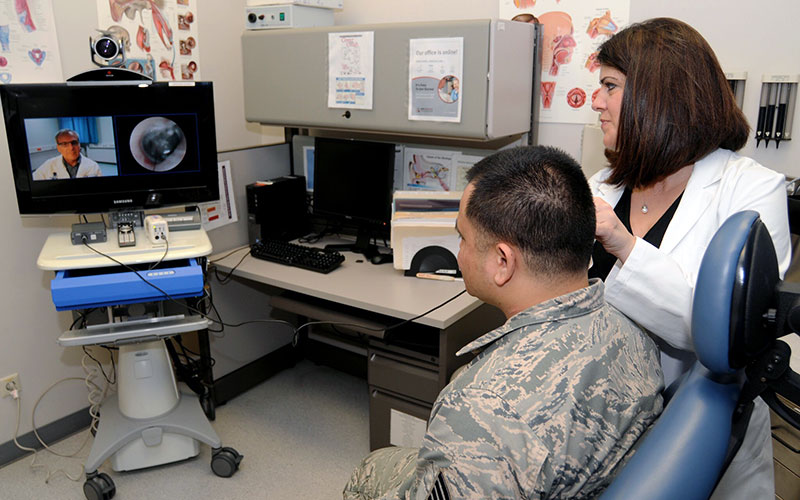
Mental health providers have switched to online platforms to continue to serve their patients during the pandemic. Two Arizona providers say that telehealth is effective in providing effective care, although there are limitations. (Photo by Edward Jenner/Creative Commons)
PHOENIX – Telehealth can help treat people with depression or other mental-health issues but patients need to guard their privacy and consider whether the treatment is right for them, health advocates said.
June Rolph, a board-certified nurse practitioner in Phoenix, said patients may feel more emotionally removed from the therapeutic process in a video session than they might in a traditional setting.
“It can feel a little more separate,” Rolph said.
But patients may feel safer in their own home than a therapist’s office.
“In a sense it’s their territory,” said Roph, who treats patients struggling with depression, anxiety and other mental health issues. That sense of security may help patients feel more comfortable answering personal questions.
Brent Marshall, an outpatient therapist and clinical supervisor in Phoenix who specializes in trauma centered therapy, said people with motivational issues, physical limitations and those who lack transportation benefit from telehealth.
Telehealth has downsides. Not everyone has access to these services, including patients in long term psychiatric facilities and those without equipment or good internet connections. Insurance doesn’t cover the costs for some, and patients have to make sure their medical provider has the right privacy standards in place for online sessions.
The COVID-19 pandemic has restricted mental health patients to online therapy sessions regardless of their personal preferences. Rolph said online platforms have been well-received by many of her patients and reluctantly accepted by others.
Mental health care during a pandemic
When the pandemic was declared in March, Rolph switched to providing all of her services through telehealth.
“It was really scary,” Rolph said, adding that COVID-19 was the No. 1 topic she discussed with clients.
“People would talk about family members that were sick. Friends that were ill. The fact that they’re so isolated,” Rolph said.
Many of her patients experienced high levels of stress from having to quarantine.
“For some patients, the only time they leave the house even before COVID was to go to their appointments,” she said. “So, to not even have that has been hard for many.”
Marshall said telehealth has helped to normalize quarantine practices.
“It’s OK to stay home,” he said. “It’s OK to be safe. Eventually we’ll get to a point where we can get you out and about.”
Virtual therapy sessions are especially useful when the client is incapable of explaining the issues they face. Rolph said children, who are most familiar with screens, may feel more at ease speaking to a stranger through the computer than they would in-person.
“It could feel safer talking to someone through a video while they get to play with the toys they have at home then it might be to come to a strange place with a provider and they may not even understand what that means,” she said.
Telehealth has limitations
Whether telehealth works well can depend on the skills of the therapist, the nature of the therapy and the patient’s needs.
Marshall points to EMDR, eye movement desensitization and reprocessing – a therapeutic protocol used mainly with trauma patients and requires the patient to follow a repetitive motion or sound with their eyes. Therapists can use anything to complete the motion, such as their fingers. Marshall said there are also applications that supply the motion for EMDR.
Such therapeutic practices are harder to do over virtual platforms because technical difficulties, including bad internet connections, can disrupt the experience. Therapists should be aware of the difficulties beforehand, he said.
Another issue with online platforms is they can disrupt the human need to gather in groups to talk.
The National Alliance on Mental Illness, or NAMI, offers free classes and support groups to teach families how to communicate with struggling relatives and navigate the mental health system. David Delawder, president of NAMI Southern Arizona, said volunteers continue to answer calls at their office to help, even if it means they direct callers to other agencies.

June Rolph, a board-certified nurse practitioner in Phoenix, serves patients who are struggling with depression, anxiety and other mental health issues. When she switched to telehealth after the pandemic began, she says, COVID-19 was the leading topic patients wanted to discuss. (Photo courtesy of June Rolph)
Most classes have been moved online, but Delawder emphasized the benefits of in-person interaction for those who need treatment.
“There’s definitely a desire to meet face to face again,” he said, “because there’s something different when you’re in a roomful of people and you’re just connecting and laughing all together.”
Delawder said some patients reject the telehealth option, adding, “We have some people on our waiting list who are just going to wait until we can serve people again in person.”
Security concerns in telehealth
Rolph said some patients worry about cybersecurity. She encourages them to ask their health care providers whether they’re using software compliant with the Health Insurance Portability and Accountability Act, or HIPAA, which sets privacy standards protecting a person’s medical records and other health information.
Rolph said most mental health providers who require payment use HIPAA compliant software to complete virtual therapy sessions, ensuring that no one will be able to gain access to sessions without permission. Paid versions of well-known video chat programs such as Zoom and Teams meet those standards, she said.
No laws to require telehealth
There’s no law that says facilities, counselors or therapists have to provide telehealth services, which could mean long term mental-health facilities might not do so.
Those with severe mental illnesses may be housed in psychiatric care facilities for years at a time and may not have a telehealth option, said Corey Lovato, a staff attorney at Arizona Center for Disability Law who helps people with severe mental illnesses or developmental disabilities who face discrimination.
Some inpatient psychiatric facilities were overlooked in Gov. Doug Ducey’s executive order encouraging mental health facilities to provide telemedicine services and ordered insurance companies to cover those services, Lovato said.
Ducey administered a grant program that gave $10,000 each to 159 licensed skilled nursing facilities and intermediate care facilities to implement telehealth procedures amid the COVID-19 pandemic.
Lovato said some facilities may not be legally obligated to provide those options at all, or they didn’t receive the funding to do so. Patients at these facilities can feel isolated when they do not have access to video conferencing options.
Their families and caretakers may experience increased worry about their loved one’s well-being if they can’t see them.
“Just to lose that element of closeness that comes from being able to talk to someone is tremendously difficult,” Lovato said.


